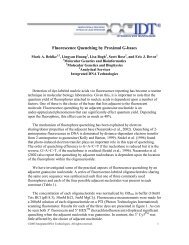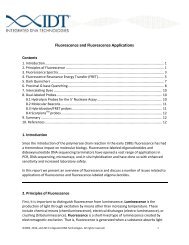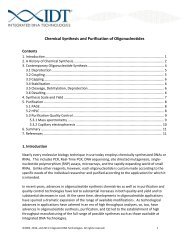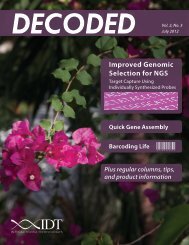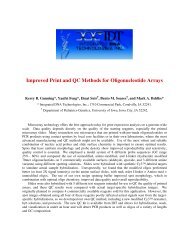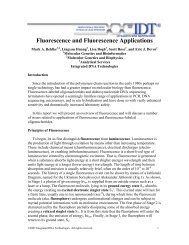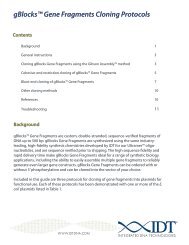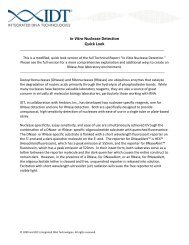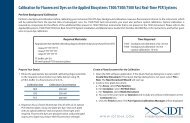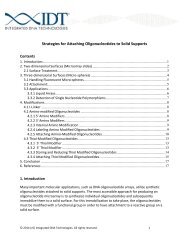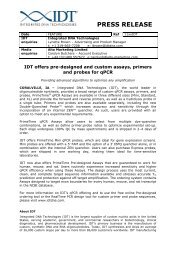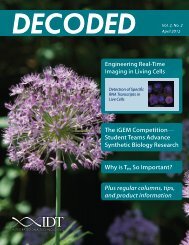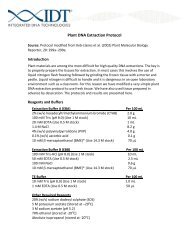Strategies for Attaching Oligonucleotides to Solid Support
Strategies for Attaching Oligonucleotides to Solid Support
Strategies for Attaching Oligonucleotides to Solid Support
You also want an ePaper? Increase the reach of your titles
YUMPU automatically turns print PDFs into web optimized ePapers that Google loves.
<strong>Strategies</strong> <strong>for</strong> <strong>Attaching</strong> <strong>Oligonucleotides</strong> <strong>to</strong> <strong>Solid</strong> <strong>Support</strong>s<br />
Quick Look<br />
______________________________________________________________________________<br />
This is a modified, quick look version of the full Technical Report “<strong>Strategies</strong> <strong>for</strong> <strong>Attaching</strong><br />
<strong>Oligonucleotides</strong> <strong>to</strong> <strong>Solid</strong> <strong>Support</strong>s.” Please see the full version <strong>for</strong> a more comprehensive<br />
explanation and detailed chemical reactions.<br />
______________________________________________________________________________<br />
Many important molecular applications, such as DNA oligonucleotide arrays, utilize synthetic<br />
oligonucleotides attached <strong>to</strong> solid supports. The most accessible approach <strong>for</strong> producing an<br />
oligonucleotide microarray is <strong>to</strong> synthesize individual oligonucleotides and subsequently<br />
immobilize them <strong>to</strong> a solid surface. For this immobilization <strong>to</strong> take place, the oligonucleotides<br />
must be modified with a functional group in order <strong>to</strong> have attachment <strong>to</strong> a reactive group on a<br />
solid surface.<br />
Surface Modification<br />
<strong>Oligonucleotides</strong> can be attached <strong>to</strong> flat two-dimensional surfaces, such as glass slides, as well as<br />
<strong>to</strong> three-dimensional surfaces such as micro-beads and micro-spheres. Construction of arrays<br />
involves a number of parameters each of which must be optimized <strong>for</strong> efficient and effective<br />
experimental design.<br />
________________________________________________________________________________<br />
Two-dimensional Surfaces (Microarray slides)<br />
Substrates <strong>for</strong> arrays are usually silicon chips or glass microscope slides. Most attachment<br />
pro<strong>to</strong>cols involve chemically modifying the glass surface <strong>to</strong> facilitate attachment of the oligo.<br />
Silianized oligonucleotides can also be covalently linked <strong>to</strong> an unmodified glass surface [1].<br />
Different modifications allow immobilization on<strong>to</strong> different surfaces:<br />
Modification Surface treatment<br />
NH2-modified oligos Epoxy silane or<br />
Isothiocyanate coated glass slide<br />
Succinylated oligos Aminophenyl or<br />
Aminopropyl-derivatized glass slide<br />
Disulfide modified oligos Mercap<strong>to</strong>silanized glass support<br />
Hydrazide (I-Linker TM ) Aldehyde or Epoxide<br />
© 2009 and 2011 Integrated DNA Technologies. All rights reserved.
Issues <strong>to</strong> consider when choosing and appropriate support and attachment chemistry:<br />
• Level of scattering and fluorescence background in the support material and added<br />
chemical groups<br />
• Chemical stability and complexity of the construct<br />
• Amenability <strong>to</strong> chemical modification or derivatization<br />
• Surface area<br />
• Loading capacity and the degree of non-specific binding of the final product [2]<br />
Surface Treatment<br />
The two-dimensional surface is typically prepared by treating the glass or silicon surface with an<br />
amino silane which results in a uni<strong>for</strong>m layer of primary amines or epoxides [2, 3]. A low surface<br />
coverage of the oligonucleotide probe will yield a correspondingly low hybridization signal and will<br />
decrease the hybridization rate. Conversely, high surface densities may result in steric<br />
interference between the covalently immobilized oligonucleotides which may impede access <strong>to</strong><br />
the target DNA strand [2]. In addition, the planar surface structure of glass slides or silicon chips<br />
can limit the loading capacity of oligonucleotides. To address this limitation, acrylamide gels can<br />
be applied <strong>to</strong> glass slides <strong>to</strong> construct a three-dimensional surface which will greatly increase the<br />
surface area per spot [4, 5].<br />
________________________________________________________________________________<br />
Three-dimensional Surfaces (Micro-spheres)<br />
In these micro-sphere-based assays, each oligonucleotide is attached <strong>to</strong> a micro-sphere. The<br />
micro-spheres can be individually assayed, usually with a flow cy<strong>to</strong>meter, or isolated based on the<br />
physical characteristics of the bead.<br />
Attachment:<br />
Nucleic acids can be covalently attached <strong>to</strong> micro-spheres with any of several methods. Carboxyl<br />
and amino groups are the most common reactive groups <strong>for</strong> attaching ligands <strong>to</strong> surfaces.<br />
<strong>Attaching</strong> an amino group <strong>to</strong> the 5’ or 3’ end of an oligonucleotide or a PCR primer is<br />
straight<strong>for</strong>ward and inexpensive. The amine-modified oligos can then be reacted with<br />
carboxylate-modified micro-spheres with carbodiimide chemistry in a one-step process at pH 6-8<br />
(Figure 1).<br />
A number of reactive groups can be used <strong>for</strong> coupling <strong>to</strong> micro-spheres such as Carboxylic acid (-<br />
COOH), Hydrazide (-CONHNH2), Primary aliphatic amine (-RNH2), Aldehyde (-CHO), Aromatic amine<br />
(-ArCH2Cl), Hydroxyl (-OH), Chloromethyl (vinyl benzyl chloride) (-ArCH2Cl), Thiol (-SH), Amide (-<br />
CONH2), and Epoxy (-COC-).<br />
________________________________________________________________________________<br />
© 2009 and 2011 Integrated DNA Technologies. All rights reserved.
Oligonucleotide modifications (Available at IDT)<br />
• I-Linker TM<br />
• Amine-modified oligos covalently linked <strong>to</strong> an activated carboxylate group or succinimidyl<br />
ester<br />
• Thiol-modified oligos covalently linked via an alkylating reagent such as an iodoacetamide<br />
or maleimide<br />
• Acrydite TM -modified oligos covalently linked through a thioether<br />
• Digoxigenin NHS Ester<br />
• Cholesterol-TEG<br />
• Biotin-modified oligos captured by immobilized Streptavidin<br />
I-Linker<br />
I-Linker is a hydrazide attachment chemistry <strong>for</strong> oligonucleotides that was developed at IDT. The<br />
modifier is attached <strong>to</strong> the 5'-end of the oligo. I-Linker can be substituted <strong>for</strong> amino modifications<br />
in many applications. In addition, I-Linker expands the range of reactive groups that can be used<br />
<strong>for</strong> conjugation, including aldehyde and ke<strong>to</strong>ne-modified ligands or surfaces.<br />
TM<br />
Amino-Modified <strong>Oligonucleotides</strong><br />
The attachment of an amino-modified oligonucleotide <strong>to</strong> a surface or another molecule requires<br />
an acylating reagent. Depending on which acylating reagent is used, carboxamides, sulfonamides,<br />
ureas, or thioureas are <strong>for</strong>med upon reaction with the amine moiety. The kinetics of the reaction<br />
depends on the reactivity and concentration of both the acylating reagent and the amine. When<br />
using any amine-reactive reagent, avoid buffers that contain free amines, such as Tris and glycine.<br />
Attachment chemistries currently in use <strong>for</strong> amino modified oligonucleotides <strong>for</strong> linkage <strong>to</strong><br />
molecule or surface:<br />
Acylating Agent Linkage Features<br />
Carbodiimide Carbonyl amide Most common method, stable<br />
attachment<br />
Isothiocyanate Thiourea Stable covalent attachments<br />
Sulfonyl chloride sulfonamide Sulfonyl chloride is unstable in<br />
water, but once conjugated <strong>to</strong><br />
the oligo the sulfonamide bond<br />
is very stable<br />
Succinimidyl esters (NHS-ester) carboxamide Carboxamide bond <strong>for</strong>med is<br />
very stable<br />
For detailed chemical reactions, please refer <strong>to</strong> the full length technical report.<br />
© 2009 and 2011 Integrated DNA Technologies. All rights reserved.
Attachment of amine-modified oligos <strong>to</strong> Surfaces:<br />
• An epoxide-opening reaction will generate a covalent linkage between a 5’-amino-modified<br />
oligonucleotide and an epoxy silane-derivatized glass surface [3, 6].<br />
• Reacting the surface bound amino groups with excess p-phenylene 1,4 diisothiocyanate<br />
(PDC) will convert the support’s bound primary amines <strong>to</strong> amino-reactive<br />
phenylisothiocyanate groups. This is followed by a reaction which couples the 5’aminomodified<br />
oligos <strong>to</strong> the phenylisothiocyanate and resulting in the covalent attachment of<br />
the oligonucleotide [2].<br />
Modifications include using homobifunctional crosslinking agents <strong>to</strong> convert glass bound<br />
amino groups:<br />
- (DCS) disuccinimidylcarbonate– converts <strong>to</strong> reactive isothiocyanates<br />
- (DSO) disuccinimidyloxalte– converts <strong>to</strong> reactive N-hydroxysuccimimidy-esters<br />
(NHS-esters)<br />
- (DMS) dimethylsuberimidate– converts <strong>to</strong> reactive imidoesters<br />
- EDC (1-ethyl=3-(3-dimethylaminopropl)-carbodiimide hydrochloride) is a<br />
heterobifunctional cross linker that has been employed with numerous supports<br />
such as amino controlled-pore glass [7], latex beads [8, 9], dextran supports [10],<br />
and polystyrene [11]. The use of EDC <strong>to</strong> bind oligonucleotides on<strong>to</strong> glass surfaces<br />
has been widespread [12, 13].<br />
Thiol-Modified <strong>Oligonucleotides</strong><br />
The thiol SH modifier can be placed either at the 5’ end or 3’ end of an oligo and enables covalent<br />
attachment of an oligo <strong>to</strong> a variety of ligands. Maleimide, bromide, iodide, or sulphonyl<br />
derivatives are suitable <strong>for</strong> tagging thiol-linked oligonucleotides with a variety of groups such as<br />
fluorescent dyes [14], biotin [15], and alkaline phosphates [16]. The thiol modification also<br />
enables attachment <strong>to</strong> solid surfaces via a disulphide bond [17] or malemide linkages.<br />
To ensure full reactivity, thiol-modified oligos should be reduced immediately be<strong>for</strong>e use. In<br />
general, the oligo is treated with a reducing agent (like DTT) and this agent is fully removed prior<br />
<strong>to</strong> coupling. Please refer <strong>to</strong> the full length technical report <strong>for</strong> specific pro<strong>to</strong>cols <strong>for</strong> this<br />
treatment.<br />
Cross-linkers used <strong>for</strong> attachment of thiol-modified oligos:<br />
The cross-linkers used <strong>to</strong> attach thiol-modified oligonucleotides <strong>to</strong> solid supports are<br />
heterobifunctional, meaning that they possess functional groups capable of undergoing a reaction<br />
with two chemically distinct function groups, amines and thiols. The linkers serve two purposes:<br />
<strong>to</strong> covalently bind two distinct chemical entities which otherwise would remain un-reactive <strong>to</strong>ward<br />
each other and as a physical spacer which provides greater accessibility and or freedom <strong>to</strong> each of<br />
the linked biomolecules [12]. One such cross linker, succinimidyl 4-maleimidophenylbutyrate<br />
(SMPB) can be used <strong>to</strong> link a thiol-modified oligo <strong>to</strong> an amine derivatized solid support.<br />
Acrydite<br />
Proprietary small molecule attachment chemistry, developed by Apogent Discoveries, enables<br />
covalent attachment of macromolecules <strong>to</strong> surfaces via acrylic linkages. An acrylic acid group can<br />
be directly attached <strong>to</strong> the 5’-end of an oligonucleotide (with a 6-carbon linker arm) at the time of<br />
TM -Modified <strong>Oligonucleotides</strong><br />
© 2009 and 2011 Integrated DNA Technologies. All rights reserved.
synthesis using Acrydite TM , an acrylic-phosphoramidite developed by Mosaic Technologies. The<br />
Acrydite TM chemistry is stable prior <strong>to</strong> coupling and will remain stable in aqueous solutions over a<br />
wide range of temperature and pH. In addition, it is versatile and can be immobilized on glass,<br />
polymer, or chroma<strong>to</strong>graphy media.<br />
Attachment of Acrydite TM -Modified <strong>Oligonucleotides</strong><br />
The Acrydite TM acrylamide group has been used <strong>to</strong> immobilize oligonucleotides, which are fully<br />
available <strong>for</strong> hybridization, <strong>to</strong> thiol-modified glass slides. Immobilization can be accomplished with<br />
standard inexpensive gel polymerization techniques that are already widely used in molecular<br />
biology labora<strong>to</strong>ries. When an aqueous solution with Acrydite TM modified material is<br />
copolymerized with another monomer, such as acrylamide, and with a crosslinker, such as bis, the<br />
resulting product is a crosslinked gel with the concentration of nucleic acids in the polymer<br />
determined by input concentrations and the ratio of Acrydite TM -modified material <strong>to</strong> monomer.<br />
The attachment <strong>to</strong> solid phases occurs with the <strong>for</strong>mation of high stable carbon-carbon or<br />
thioether bonds which are stable in all conditions routinely encountered in standard molecular<br />
biology pro<strong>to</strong>cols.<br />
References<br />
1. Kumar A, Larsson O, et al. (2000) Silanized nucleic acids: a general plat<strong>for</strong>m <strong>for</strong> DNA<br />
immobilization. Nucleic Acids Res, 28(14): E71.<br />
2. Guo Z, Guilfoyle RA, et al. (1994) Direct fluorescence analysis of genetic polymorphisms by<br />
hybridization with oligonucleotide arrays on glass supports. Nucleic Acids Res, 22(24):<br />
5456−5465.<br />
3. Lamture JB, Beattie KL, et al. (1994) Direct detection of nucleic acid hybridization on the<br />
surface of a charge coupled device. Nucleic Acids Res, 22(11): 2121−2125.<br />
4. Mirzabekov AD. (1994) DNA sequencing by hybridization--a megasequencing method and a<br />
diagnostic <strong>to</strong>ol? Trends Biotechnol, 12(1): 27−32.<br />
5. Proudnikov D, Timofeev E, and Mirzabekov A. (1998) Immobilization of DNA in<br />
polyacrylamide gel <strong>for</strong> the manufacture of DNA and DNA-oligonucleotide microchips. Anal<br />
Biochem, 259(1): 34−41.<br />
6. Beattie WG, Meng L, et al. (1995) Hybridization of DNA targets <strong>to</strong> glass-tethered<br />
oligonucleotide probes. Mol Biotechnol, 4(3): 213−225.<br />
7. Ghosh SS and Musso GF. (1987) Covalent attachment of oligonucleotides <strong>to</strong> solid supports.<br />
Nucleic Acids Res, 15(13): 5353−5372.<br />
8. Wolf SF, Haines L, et al. (1987) Rapid hybridization kinetics of DNA attached <strong>to</strong> submicron<br />
latex particles. Nucleic Acids Res, 15(7): 2911−2926.<br />
9. Lund V, Schmid R, et al. (1988) Assessment of methods <strong>for</strong> covalent binding of nucleic acids<br />
<strong>to</strong> magnetic beads, Dynabeads, and the characteristics of the bound nucleic acids in<br />
hybridization reactions. Nucleic Acids Res, 16(22): 10861−10880.<br />
10. Gingeras TR, Kwoh DY, and Davis GR. (1987) Hybridization properties of immobilized<br />
nucleic acids. Nucleic Acids Res, 15(13): 5373−5390.<br />
© 2009 and 2011 Integrated DNA Technologies. All rights reserved.
11. Rasmussen SR, Larsen MR, and Rasmussen SE. (1991) Covalent immobilization of DNA on<strong>to</strong><br />
polystyrene microwells: the molecules are only bound at the 5' end. Anal Biochem, 198(1):<br />
138−42.<br />
12. Chrisey LA, Lee GU, and O'Ferrall CE. (1996) Covalent attachment of synthetic DNA <strong>to</strong> selfassembled<br />
monolayer films. Nucleic Acids Res, 24(15): 3031−3039.<br />
13. O'Donnel MJ, Tang K, et al. (1997) High-Density, Covalent Attachment of DNA <strong>to</strong> Silicon<br />
Wafers <strong>for</strong> Analysis by MALDI-TOF Mass Spectrometry. Anal Chem, 69: 2438−2443.<br />
14. Connolly BA and Rider P. (1985) Chemical synthesis of oligonucleotides containing a free<br />
sulphydryl group and subsequent attachment of thiol specific probes. Nucleic Acids Res,<br />
13(12): 4485−4502.<br />
15. Sproat BS, Beijer B, et al. (1987) The synthesis of protected 5'-mercap<strong>to</strong>-2',5'dideoxyribonucleoside-3'-O-phosphoramidites;<br />
uses of 5'-mercap<strong>to</strong>oligodeoxyribonucleotides.<br />
Nucleic Acids Res, 15(12): 4837−4848.<br />
16. Li P, Medon PP, et al. (1987) Enzyme-linked synthetic oligonucleotide probes: nonradioactive<br />
detection of entero<strong>to</strong>xigenic Escherichia coli in faecal specimens. Nucleic Acids<br />
Res, 15(13): 5275−5287.<br />
17. Bischoff R, Coull JM, and Regnier FE. (1987) Introduction of 5'-terminal functional groups<br />
in<strong>to</strong> synthetic oligonucleotides <strong>for</strong> selective immobilization. Anal Biochem, 164(2):<br />
336−344.<br />
© 2009 and 2011 Integrated DNA Technologies. All rights reserved.



